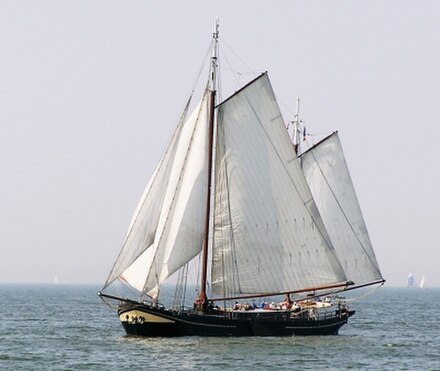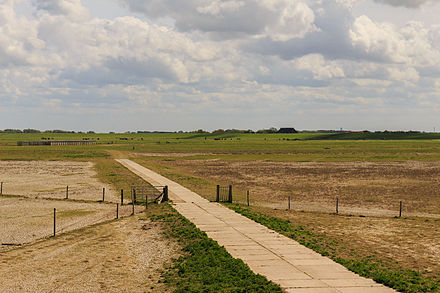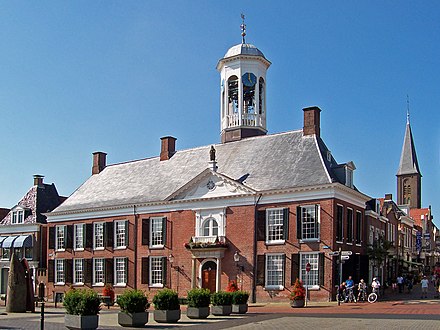Friesland - province of the Netherlands
Friesland (dead link: August 2020) (West Frisian: Fryslân, Dutch: Friesland) is a province of the Netherlands. It is known for its unique language and culture. Friesland has a Nordic feel to it. It has a strong sports culture: ice skating is the most popular sport, and is done along indigenous sports such as fierljeppen (pole-jumping over a watered didge) and skûtjesilen (sailing in old cargo ships).
Cities

- Leeuwarden — capital of Friesland with an historic city centre
- Balk
- Bolsward
- Dokkum
- Drachten
- Franeker
- Harlingen
- Heerenveen
- Hindeloopen
- IJlst
- Joure
- Sloten
- Sneek — the annual Sneekweek boating event, gateway to the Frisian Lakes
- Stavoren
- Workum
Other destinations
- Frisian Lakes — about two dozen lakes the Southwestern part of Friesland, popular in the summer among boaters
- West Frisian Islands — islands in the Wadden Sea, a UNESCO World Heritage Site, that can be traversed by mudflat hiking
Understand
Friesland has a long history. Its inhabitants are first referred to by the Roman writer Tacitus, in his work Germanica. After the collapse of the Roman Empire, Frisia grew in importance, and at one point Frisian kings controlled the entire coast of what is now the Netherlands up into Belgium and parts of Northern Germany (which is still known as East Frisia).
The Frisians were later subjugated by Charlemagne, and have never achieved independence since. During the Dutch golden age in the 16th and 17th century, Frisia has stood in the shadow of Holland, remaining largely rural while trade and later industry flourished in other parts of the Netherlands. During this period, peat was dug from the soil, causing lakes to form. Also, all transport was done via water. This combination of lakes and connecting canals has made Friesland a mecca for water sports enthausiasts.
Frisia is one of the most sparsely populated provinces in the Netherlands (with only 160 people/km², compared to 488 people/km² for the whole country, or 67 people/km² for Scotland) and is mostly known for its lakes, wide open spaces, and general peace and quiet, as well as for its population. As the Netherlands are sometimes referred to as Holland, let it be known that Friesland is not part of Holland. This is a common mistake among tourists, and one which can be almost guaranteed to grossly offend any native Frisian you may be talking to. Holland comprises only the (coastal) provinces of North Holland and South Holland.
Ice skating
The 11-cities-tour (Dutch: elfstedentocht, West Frisian: alvestêdetocht) is a skating event, which can only be held in winter when all the water through and between those 11 cities is frozen. Friesland has only 11 cities, settlements with historical city rights. They vary in size from the provincial capital Leeuwarden (+92,000 inhabitants) to Sloten, with less than 1,000 inhabitants.
Flag
Although the use of the flag of Friesland dates back to mediaeval times, the current flag was only adopted in 1957. It is used to promote the province across all of the Netherlands and is also widley used on souvenirs. The seven red water-lilies (not hearts) represent the seven origina areas of Friesland.
Talk
 Friesland is bilingual, with West Frisian, the local language, enjoying equal status with Dutch. Everyone in Friesland is able to speak Dutch; however the preference for Frisian is strong with some. Signs, streetnames, etc. are mostly in two languages, depending on the community council.
Friesland is bilingual, with West Frisian, the local language, enjoying equal status with Dutch. Everyone in Friesland is able to speak Dutch; however the preference for Frisian is strong with some. Signs, streetnames, etc. are mostly in two languages, depending on the community council.
The Dutch name of the language is Fries (West Frisian: Frysk), with Westfries being the name of the Dutch dialect in the northern part of the province North-Holland.
As in the rest of the Netherlands, almost everyone in Friesland speaks at least some English, and especially young people are likely to be fluent or near-fluent.
Get in
By train one can travel from the direction of Groningen or Zwolle. And by bus from Den Helder or Hoorn. In the latter case you will pass over the Afsluitdijk, a 30 km long dike separating two seas. The bus stops at a viewpoint halfway on the dike.
There is a ferry running from Enkhuizen in Noord Holland to Stavoren. The journey takes around 80 minutes. In the summer the ferry runs up to three times daily, but in April and October not as frequent. The fare for adults is €10.60. Check timetables here.
Get around
The train system is low-grade by Dutch standards, which means that only the major cities are connected by rail. Sneek, Leeuwarden, Franeker, Harlingen, Heerenveen and Grou are accessible by rail. To get to the smaller town towns you will have to take buses, which usually leave from the train stations as well. See the article on the Netherlands for more details on the baroque system of public transport, and note that bus services will be sparse in the summer vacation.
Another way to get around is by boat. Friesland is noted for its large amount of lakes, but especially for the way they are all interconnected by canals. It is therefore possible to travel from one city to the next by sailing-boat. See the Do section for more information.
Like the entire Netherlands, Friesland is extremely bike-friendly. See the main article on the Netherlands for details.
See

- Wieuwerd mummies - a small town where local church crypt created the right conditions for natural mummification
- Fries museum - the local museum on the area (located in Leeuwarden)
- Jopie Huisman museum (Workum) - an art museum dedicated to an eel fisher turned realist painter
- Eise Eisinga's planetarium (Franeker) - a school teacher created the world's oldest still working planetarium (1774) to disprove claims that the world was going to end
- Hindeloopen - a small town comparable to Volendam or Marken, though not as overly touristic
- Sloten - a small fortress town with a rich past
Afsluitdijk
The Afsluitdijk is a 32 km long dike connecting North-Holland and Friesland. Built in 1927-1932 to close what is now the IJsselmeer from being flooded by the North Sea. The dike was built as part of a plan to reclaim land in the IJsselmeer; this land became the province of Flevoland. You can ride on the dike by car, what may shorten travelling considerately.
- The Kazematten Museum. The bunkers defending the entrance to the Afsluitdijk were a vital part of Hollands defence plan during the Second World War. Some of the bunkers have been restored, with period-appropriate weapons, equipment and everyday items giving an overview of the soldiers' life inside the bunkers in 1940.
- Het Monument. A small statue of a dike-builder which has been placed on the spot where the dike was closed in 1932. Next to the monument is a plaque, cafe and a watchtower where (because of all the water) you can see the Wadden islands on a bright day.
Do
 There are many activities you can undertake in Friesland:
There are many activities you can undertake in Friesland:
The main event in Friesland each year is the yearly sailing contest between 14 ships on the various lakes, which takes place in early August. The 14 10-meter long boats, each with a crew of more than ten people, compete over 14 matches on anything from the huge IJsselmeer to tiny Veenhoop. This event is called Skûtsjesilen, Skûtsje being the traditional type of sailing boat used in these contests.
It is quite possible to watch these matches from the shore, and many people do so. Inquire locally about the best place to watch, and be prepared to come early or the locals will beat you to the best places. It is also possible to watch these matches from the water, but some areas of water may be off-limits for spectators.
If you are traveling by boat, make sure you get a program of this because certain lakes or parts of lakes will be closed off, and the waterways towards those lakes will be filled with traveling spectators.
- Go boating on the lakes or canals.
- Go mudflat hiking to the West Frisian Islands. As the sea is dry at lowtide, it is possible to walk to some of the islands. Always do this under supervision of a licensed guide. Though tides change in regular cycles, these are easily misjudged by unqualified hikers, who could find themselves quickly surrounded by rising water on all sides. As hikers are basically walking in the middle of the sea, this is not to be underestimated.
- Kaatsen is a sport dating to the Middle Ages, still being practised in Friesland, the Basque Country, and parts of southern France. A precursor to tennis; the game consists of two teams hitting a solid leather ball with their bare hands. The main event each year is the PC, in Franeker. The city will be filled with spectators. Warning: Kaatsen is to Frisians what cricket is to the English, i.e.: you will not understand a thing of what is happening.
- Fierljeppen (far-jumping) - a sport where contestants attempt to jump as far as possible over a ditch, using a 10-foot pole.
- Follow the route of the Elfstedentocht by car or by bicycle. Seven of the original cities of the tour are in this area, namely Sneek, IJlst, Sloten, Stavoren, Hindeloopen, Workum, and Bolsward. You can get a detailed map of the route at tourist offices throughout the area, and suggestions on how to traverse the route.
- Hindelooopen Cycle Route (51 or 45 km) takes you through the flat, open pastureland of Friesland, famous for its Frisian cows to several of Friesland's lakes. Highlights of the route are the Hanseatic towns of Workum and Hndeloopen.
Eat
- Fryske dúmkes, sweet cookies with crushed hazelnut
- Oranjekoeke, a kind of cake with orange snippers
- Drabbelkoeken, a buttercake, only in Sneek
- Sûkerbôle, a sweet bread with 40% sugar and cinnamon
Drink
- Beerenburg, the "national" drink of Friesland. An alcoholic drink, made by adding herbs to jenever. It has an alcohol percentage of around 30%.
- Frysk Hynder (Frisian horse), the only Frisian whisky, distilled in Bolsward.
- Ús Heit (Our father), Frisian beers, brewed in Bolsward
Stay safe
Respect
Do not refer to the local language as a dialect of Dutch, as this might be considered insulting, as well as being untrue. Although they are closely related, and nearly all Frisian people are able to speak Dutch, the language is old and distinct, bearing more linguistic similarities to English than to Dutch. Otherwise, the general mentality and rules of etiquette are the same as in the rest of the Netherlands. The region is by no means separatist, but there is a strong national feeling among Frisians. Its relationship to the Netherlands is comparable to the relationship between Wales and England within the United Kingdom.
Go next
From Friesland, most places in the Netherlands can be reached within four hours of travel (either car or train). The neighbouring provinces are the following:
- Groningen — to the east, including the vibrant capital city Groningen
- Drenthe — to the east, known for its heathland, sand grounds and the dolmen from the early Neolithic period
- Overijssel — to the south, with the Weerribben-Wieden national park just across the provincial border
- Flevoland — to the south, reclaimed land and the large Walibi Holland theme park
- North Holland — to the west across the Afsluitdijk dam, including the North Holland Peninsula and Texel, the largest West Frisian island